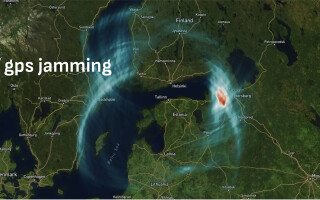Smart displays meet military vetronics demands for reduced SWaP and better security
StoryApril 19, 2012
A supplemental snapshot to "Lowering cost per mile in military vehicles drives vetronics designs," in which Editorial Director John McHale takes an introspective look into the smart displays being mounted in military vehicles.
Integrators of vetronics systems for military vehicles are moving toward Commercial Off-the-Shelf (COTS) smart displays for new platforms and vehicle retrofits, as they offer reductions in Size, Weight, and Power (SWaP) and are more cost effective to develop.
“For displays we’re seeing everything going digital in the vehicle,” says Robert Kopersiewich, Vice President of Embedded Graphics & Mission Critical Solutions at Presagis in Montreal. The types of displays being developed are integrating more and more data for the warfighter, for example, some bringing in external feeds such as live video that is overlaid on the display.
Program managers want high-end graphics capability in a rugged, compact package that ensures they can run any application from any screen in the vehicle, says Greg Downs, Vice President of Vetronics Systems for General Dynamics Canada in Ottawa, Ontario. In other words, the driver should be able to see what the gunner sees and vice versa without having to get up and go look at the other’s display, he explains. Smart display technology will solve these problems and give full access to any crew member, Downs adds.
When the vetronics displays are not integrated and mission-critical “information is not fully accessible, you don’t have real crew situational awareness in the vehicles,” Downs says. GD Canada produces smart displays that leverage Intel processor chipsets for enhanced video processing recording and high-end graphics processing, he says. The high-end graphics also enable embedded training and mission rehearsal on the platform while it is in the field. Being able to train warfighters in the field on the actual platform is also a major cost saver, Downs adds (Figure 1).
Figure 1: The 10.4-inch SD7310 smart display from General Dynamics Canada leverages Intel Core 2 Duo processors for high-performance graphics processing in vetronics applications.
(Click graphic to zoom)
The typical dimension of displays in armored fighting vehicles is a ten-inch diagonal and a twelve-inch for battle command applications, Downs says. “We are seeing a desire to have larger displays on certain programs such as some fourteen-inch displays. However, the reality of space constraints will push it back from to ten to twelve inches. We expect that will remain the most popular size.”
Security is another important trend in vetronics display designs, Downs says. The DoD wants classified and unclassified information to be accessible on the same display, he continues. They are looking for solutions “to automate the transition between security levels” so they can be consolidated onto a display or a single device. That consolidation also enables SWaP savings with the classified and unclassified data accessible on one display or computer as opposed to two of each, Downs says. Fewer displays mean more room in the vehicle and reduced power consumption, he adds.
Standard HMIs enable portability in displays
Developing display software that provides seamless integration between different vetronics displays is enabled by standards in software, specifically Human Machine Interface (HMI) technology and the ARINC 661 standard. For vetronics it is crucial to [design] HMI in a way that is deterministic and well defined for mission-critical applications, Kopersiewich says.
“ARINC 661 brings standardization across HMIs and does it cost effectively,” Kopersiewich continues. “When an OEM is building land vehicles, they want to be able to outsource the HMI design knowing that it uses a common standard that can interface with other components of the platform’s vetronics as well as being scalable and compatible with future variants,” he explains. “ARINC 661 defines how displays are designed and feed into different user applications. It provides a kind of spoke and node architecture.”
The trend that is important here is that “COTS tools make more sense as the complexity builds up,” Kopersiewich says. They can do hand-coding with OpenGL and create displays easily. It makes a lot of sense to have COTS tools used for vetronics applications, as the “vetronics displays are getting more and more complex,” he adds.
The Presagis VAPS XT software is a COTS HMI tool that uses an object-oriented architecture and OpenGL interface for supporting HMI applications for use on different types of displays and touch screens, Kopersiewich says. With a tool such as the Presagis VAPS XT, users can reconfigure a single operator station quickly for many different missions. It is easier and more cost effective to change the design code in OpenGL instead of starting from scratch each time you need to change a display, he adds.






